It’s that time of year again: Combo Breaker is almost upon us. Of the many FGC majors sprinkled throughout the US, the Chicago, IL event is most notable for its emphasis on spotlighting novel, commuinty-driven brackets – most notorious are its Mystery Game and Auction tournaments, including the cultural touchstone that was the Sarvets All-Stars tournament from 2018.
And while these kinds of events are almost certainly appearing at Combo Breaker 2022, the main stage will also be seeing a new challenger among the likes of Guilty Gear Strive and The King of Fighters XV – a Nintendo Gamecube game called Bloody Roar Extreme. This game has a small, but very passionate competitive community, and thanks to the surprising, but very welcome decision to put the game on the main stage, a lot of people are going to be watching it for the very first time. So, as someone with a reasonable amount of knowledge of (and a whole lot of love for) the Bloody Roar series, I wanted to take some time to introduce you to the basics of Bloody Roar Extreme, so you can have a bit of context to help you understand the undoubtedly awesome matches you’ll be seeing from Combo Breaker.
What is Bloody Roar?
Bloody Roar is a series of 3D fighting games developed by 8ing and published by Hudson Soft, with Bloody Roar Extreme being the fourth entry in the series, itself a Japan-exclusive version of Bloody Roar Primal Fury with a few gameplay adjustments. Much like how Dead or Alive took inspiration from Virtua Fighter in its design, Bloody Roar looks to Fighting Vipers to find its identity as a fighting game. It’s extremely fast-paced, with high damage, a complex mindgame built into its combo structure, and a slew of diverse and interesting characters with highly varied toolkits.
And all of them can turn into their fursonas.
BEASTORIZER: The BEAST Mechanic
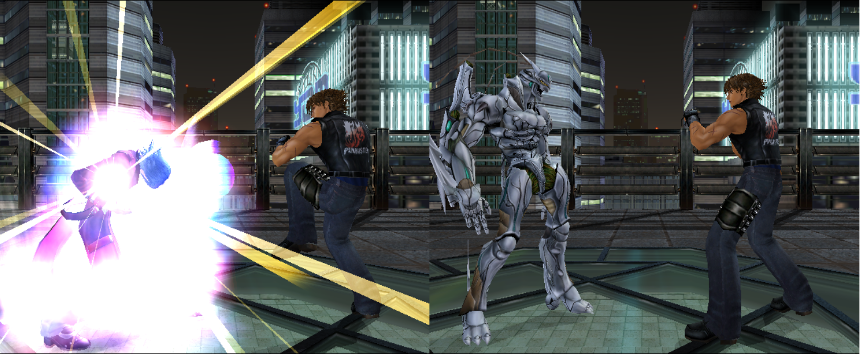
The centrepiece mechanic of Bloody Roar is, of course, the ability to turn from a human into a beast-person. Characters can enter their beast form either on the ground or in the air, and a player’s ability to go beastmode is determined by the Beast gauge at the bottom of the screen, which can be built up in human form by both dealing and taking damage. When the gauge says “BEAST CHANGE!!”, pressing the Beast button will turn the character into their Beast form. Once in Beast form, the Beast button is used for attacks available exclusively in Beast form, many of which are quite powerful. The only ways to revert back to human form are either taking damage, which reduces the Beast gauge, or by using a Beast Drive, a super attack that uses all remaining Beast gauge.
There are a number of benefits to entering Beast form. The activation itself is invincible, allowing it to act as a “get off me” tool when being pressured, and while in Beast form, characters gain access to buffed damage and defense modifiers, recoverable life regeneration, improved attack properties, and most notably, the ability to air cancel – which is, put simply, the ability to jump cancel most attacks that put the opponent into airborne hitstun – commonly launchers, but any attack that hits an airborne opponent also counts.
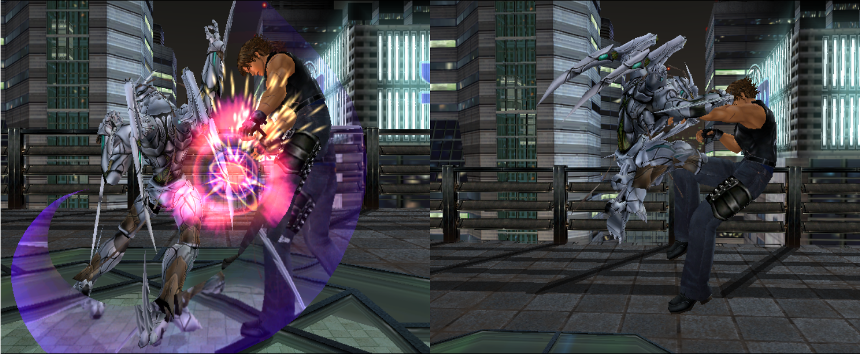
This all becomes relevant for the next important mechanic…
DO A FLIP: Aerial Ukemi
This is where the Fighting Vipers influence comes in. When a character is launched into the air by an attack, there is a short true hitstun window, after which they can ukemi (aka air tech) with a button input. Aerial ukemi in Bloody Roar Extreme is similar to a Guilty Gear or BlazBlue air tech, where the character flips, recovers in the air, and is able to act on the way down. Important to note is that aerial ukemi cannot be performed while in spinning knockdown states, heavy blowbacks, or ground bounces.
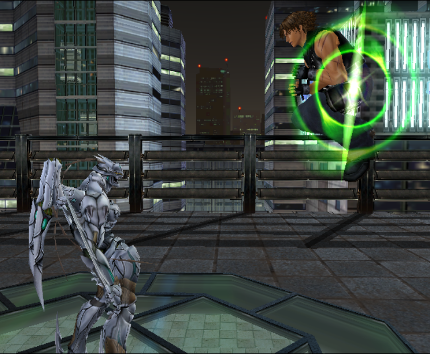
Here’s the catch, though – in Bloody Roar Extreme, aerial ukemi is fast and able to be performed in multiple directions, but critically, it does not have any invulnerability frames. This means that “tech traps” are a very important aspect of high level gameplay, as the aggressor gets to create situations for guaranteed damage with the right read, while the defender has to balance the risk of turning a standard combo into a more damaging reset, with the reward of being able to escape the damage altogether and potentially even start offense with a jumping attack. This creates a complex mindgame whenever a launch happens that really keeps the game feeling fast and dynamic.
UNDER PRESSURE: Guarding, Attack Properties and Everything In Between
Light Guard and Heavy Guard
Of course, the defensive game is equally, if not more complex when someone isn’t in the air. The starting point for this defensive complexity is in how blocking is handled. Bloody Roar Extreme gives you two ways to block attacks – light guard, performed by just keeping the stick at neutral (down for low attacks), and heavy guard performed by guarding with the Guard button. The difference between light guard and heavy guard is comparable to the difference between normal blocking and Faultless Defense in Guilty Gear. Heavy guard incurs significantly more blockstun than light guard, at the expense of being safer. Safer from what, though?
Guard Breaks
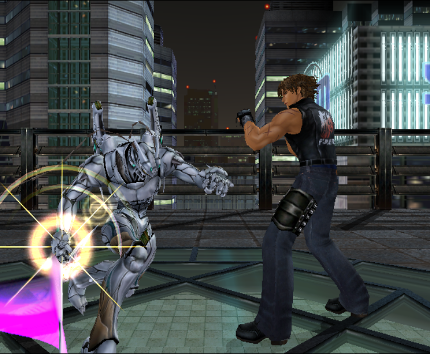
This gold spark appearing during a move’s startup signifies that the move is a guard break. Guard break attacks can only be blocked by heavy guard – attempting to block them with a light guard will cause characters to stagger backwards, taking half of the move’s damage and leaving them open to follow up combos. Guard breaks form a pretty important part of offense, as the ability to threaten with them forces players to heavy guard, leaving them susceptible to more offense that is harder to challenge.
Command Moves and Cancels
Every character has access to six special moves, known as command moves. They are all input with 236 or 214 and one of the three attack buttons (Punch, Kick or Beast). These all serve a number of different purposes depending on the move and character, but all have two universal functions. The first is that these moves can be cancelled into from certain normal attacks (these attacks are said to have cancel points), allowing for slightly more variance in grounded combos and pressure strings. The second is that all command moves can be cancelled at any point during their startup by pressing the Guard button. Combined with the aforementioned cancel points, this means that every character has consistent access to strong and varied stagger pressure options that greatly expand the game’s offense.
Guard Attacks and Dodges
Of course, to counteract the strength of command cancel strings on offense, Bloody Roar Extreme provides players with a number of useful defensive options.
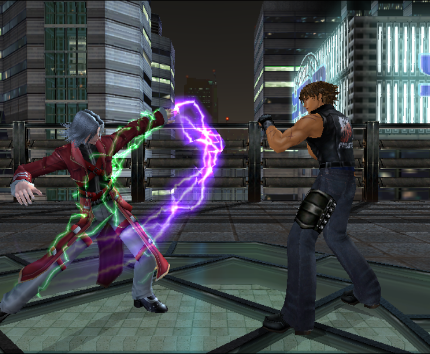 The first of these is guard attacks, which will be familiar territory to players of Tekken 7 and its Power Crush mechanic. Guard attacks are signified by green electricity coursing around the character, and function as attacks which have upper body autoguard on them. The autoguard, however, is equivalent to light guard, meaning that on top of being interruptible by lows, they will also lose outright to guard break attacks.
The first of these is guard attacks, which will be familiar territory to players of Tekken 7 and its Power Crush mechanic. Guard attacks are signified by green electricity coursing around the character, and function as attacks which have upper body autoguard on them. The autoguard, however, is equivalent to light guard, meaning that on top of being interruptible by lows, they will also lose outright to guard break attacks.
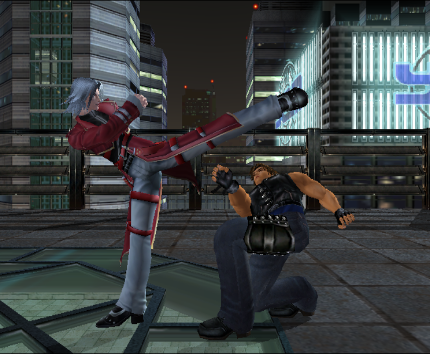 The second of these mechanics is dodge, which functions as Bloody Roar Extreme’s equivalent of a just defend mechanic. By tapping the Guard button just before an attack makes contact (about a 9F window or so), characters can dodge incoming attacks, incurring even less blockstun than they would by simply light guarding, while still being immune to guard break attacks. Dodging is a powerful defensive option, as it will work against attacks of all hit levels, and is cancellable into offensive actions, allowing players to use dodges to create opportunities to reverse momentum or even punish certain attacks.
The second of these mechanics is dodge, which functions as Bloody Roar Extreme’s equivalent of a just defend mechanic. By tapping the Guard button just before an attack makes contact (about a 9F window or so), characters can dodge incoming attacks, incurring even less blockstun than they would by simply light guarding, while still being immune to guard break attacks. Dodging is a powerful defensive option, as it will work against attacks of all hit levels, and is cancellable into offensive actions, allowing players to use dodges to create opportunities to reverse momentum or even punish certain attacks.
However, there is one weakness common to both guard attacks and dodges…
Throws and Throw Breaks
Throws in Bloody Roar Extreme are a uniquely old-school affair. Every character has access to both a basic throw, input with 6G, and a command throw, usually (but not always) input with 236G. At a base level, all throws have 1F of startup (meaning they connect instantly), but take a long time to whiff, and will lose to strikes that aren’t guard attacks, which make them most similar to throws in Virtua Fighter 3tb.
Basic throws come in two varieties – a high standing throw, and a low crouching throw. Both are input the same way, which means that the only ways to challenge a normal throw attempt are by attacking, getting out of the way, or by breaking the throw – both high and low throws can be broken by just pressing an attack button during the throw break window.
Command throws are a slightly different story, however, in that they can be ducked under, but they also have to be broken differently from basic throws – specifically by pressing 6 plus an attack button. Being aware of which throw your opponent might want to use is important, as command throws in particular are usually more rewarding than basic throws.
Critically, the throw break input being as simple as it is means that throw breaks can be option-selected into heavy guard, which is very useful, though of course comes with the weaknesses of heavy guard that we’ve already discussed.
HYPEBEAST– er, I mean: Hyper Beast
Finally, we’ll cover Hyper Beast form. Hyper Beast is essentially a powered up Beast form that is only active for a limited time. It’s activated by pressing all four buttons, and costs two full bars of the Beast gauge to activate. Notably, you can activate Hyper Beast form with less than the full two bars, so long as you have enough health to pay the difference.
Hyper Beast is effectively Bloody Roar Extreme’s version of something like a BlazBlue Overdrive. While only active for a limited time, characters in Hyper Beast form gain access to their Ability Plus, which takes the form of two special passive abilities granted to the character for the duration of Hyper Beast form. These can range from more cancel points, to forced counter hit properties on all attacks, to even just more damage on certain attacks. The abilities vary depending on the character and usually serve to reinforce some aspect of the character’s gameplan.
Additionally, Hyper Beast activation can also be used in more defensive contexts than a regular Beast activation – most importantly, it can be activated during hitstun, allowing it to fuction as a pseudo-Burst, allowing players to escape combos and certain types of knockdowns, which can give it some utility as a hail mary reversal.
A GUIDED TOUR OF THE ZOO: Character Overviews
Bloody Roar Extreme gives players 16 different characters to choose from, and all of them fit different niches and gameplay styles. You’re likely to see most (if not all) of them throughout the tournament, so this will be a brief introduction to those characters.
Note: The information for all of these overviews comes from the Bloody Roar Extreme wiki on Mizuumi.
Alice the Rabbit: A well-rounded character with great pokes, fantastic mobility and strong mixups. She can dish out some incredible damage, but her relatively steep execution requirements mean you might see a few more dropped combos from her than other characters.
Bakuryu the Mole: A sneaky, movement-focused hit and run character who excels at frustrating opponents into making mistakes, which he can capitalise on with his various teleports and attack counters. This gameplan makes it difficult for him to mount comebacks, however, so patience and unpredictability is key with Bakuryu.
Busuzima the Chameleon: A tricky, long-range zoner character similar to Street Fighter’s Dhalsim. Has incredible reach on his attacks, but relies heavily on successfully reading his opponent to score wins due to his poor mobility and low damage output.
Cronos the Penguin/Phoenix: Highly unique, in that he is the only character in the game with two Beast forms. His standard Beast form, the Penguin, is deliberately designed to be weak, but with some unique strengths centered on his ability to steal the opponent’s Beast meter with his Beast Drives. Gaining Beast meter is especially important, because his Hyper Beast form, the Phoenix, is effectively Cronos’ win condition, thanks to powerful attacks and high damage output.
Fang the Wolf: An alternate universe version of Yugo, Fang is a fairly straightforward rekka-style character with high damage output and a strong command throw. His rushdown can be powerful, but also somewhat one-note.
Gado the Lion: A heavyweight bruiser character with massive damage and a ton of guard breaks. His counterpokes and whiff punishes are highly rewarding because of this, but his lower movement speed makes capitalising on those strengths somewhat more difficult.
Ganesha the Elephant: A hard-hitting grappler character with a unique twist – he has no strings, but is instead allowed to cancel all of his normal attacks into command moves. His offense can be difficult to start, but he can snowball very quickly if he gains momentum.
Jenny the Bat: A character with a significant focus on aerial play, with air dashes, floats, dive kicks and unique aerial strings, which makes her air cancel game exceptionally strong. She also has a unique stance to apply pressure on the ground, but this comes at the expense of low defense, making it important for her to maintain momentum.
Kohryu the Iron Mole: A character with similar moves to Bakuryu, but focused more on offense. His higher weight makes him less mobile generally, but his better defensive stats make him more able to scrap in the close range, and from long-range he can take advantage of his powerful teleports and projectile attacks.
Long the Tiger: A jack-of-all-trades type character who can play offense and defense equally well. His Rokugo six-stage combo rings grant him a high degree of versatility with his pressure and combos, but his opportunities to score big damage are limited, making comebacks difficult if he’s behind on momentum.
Marvel the Leopard: Known as Shina in the US versions of Bloody Roar. A defensively-focused close-range fighter with attack feints and catch counters at her disposal to create unconventional mixup situations. Her ability to enforce those mixups is limited thanks to the way they interact with the game systems, but she can easily turn them into high damage if she makes the correct choice.
Shenlong the Tiger: A fast, brutal rushdown character who relies on dominating approach options and suffocating pressure thanks to a Rokugo combo ring with a ton of guard breaks and cancel points, as well as the all important 66P command cancel. His powerful offense, however, comes at the expense of low defense, making him a very “feast or famine” sort of character.
Stun the Insect: A more defensively focused grappler character with strong mid-range tools, as well as the game’s highest defense modifier, giving him a lot of survivability in scramble situations. He also has excellent okizeme options, but his low mobility and slow attacks means getting that knockdown can be challenging.
Uriko the Half-Beast: A pure rushdown pixie character with powerful rushdown and mixups thanks to her simplified Rokugo combo ring, but suffers from poor range and low defense, meaning she can easily fold to anyone willing to keep her out or make strong reads on her attempts to establish offense.
Xion the Unborn: A mid-range poking and zoning character who can apply powerful mixups from ranges most characters have trouble contesting, especially in his Beast form, which increases the range on his attacks. His focus on keepout as his primary strategy, however, means he fares a bit worse up close compared to other characters, thanks to low defense and relatively unrewarding throws.
Yugo the Wolf: A stance-based rushdown mixup character with excellent mobility. His close range pressure is immense, with lots of extended blockstrings and heavy guard traps, a great command throw and solid damage output. He does require some effort to enforce his mixups, though, as his low presence is limited and many of his best attacks can be easily low-profiled, which can make reversing momentum on him easier than others
And that should cover everything! Hopefully this will have given you all the knowledge you need to have a great time watching Bloody Roar Extreme.
Combo Breaker will be running from Friday, May 27 to Sunday, May 29. Keep an eye on their socials for more information on when and where the event will be streamed. Be sure to join the Bloody Roar Discord server to hook up with other Bloody Roar players and learn about the game and its characters. You can also check out JeritheOG’s youtube channel for gameplay guides, as well as HyperBeast TV for match footage. See you in the stream chat!